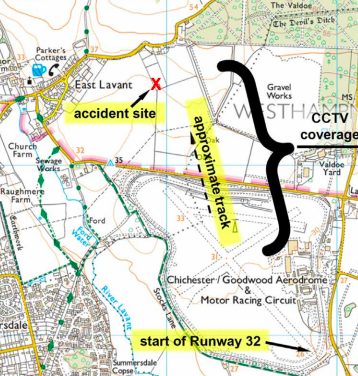Partial Power Loss Results in Downed Rogers Sky Prince G-CJZU in West Sussex

On June 30, 2021, at 3:36 pm, a 2009 Rogers Sky Prince G-CJZU suffered a partial power loss near Goodwood Aerodrome, West Sussex, after takeoff.
After takeoff, the engine in Rogers Sky Prince G-CJZU suffered a partial power loss. This power loss became more significant as the aircraft reached 300 ft aal. The aircraft had little natural stall warning and was not fitted with an artificial stall warning device. A safe flying speed was not maintained, and the aircraft departed from controlled flight at a height from which it was not possible to recover. The aircraft descended steeply and struck the ground nose first. The accident was not survivable.
Examination of the engine of the G-CJZU could not find any faults that could have caused or contributed to the partial power loss
The aircraft had sufficient fuel for the flight. Insufficient supply of fuel to the engine from the tanks could have caused the power reduction but the damage to the aircraft meant that it was not possible to establish the condition of the fuel system or level of fuel supply. It is also possible that a fault in the ignition system could have contributed to the power reduction, but the damage from the post impact fire meant that the integrity of the electrical system could not be fully assessed. Weather conditions were also conducive to carburettor ice forming on the taxi out to the runway. It is possible that carburettor ice formation caused the engine to lose power after takeoff.
While the investigation of G-CJZU was in progress, a further event involving partial power loss occurred in which the three occupants of the aircraft were seriously injured
The aircraft suffered a partial loss of engine power shortly after takeoff and the pilot attempted a turnback to land on the reciprocal runway. The aircraft stalled during the turn and struck the ground west of the runway.
Three Safety Recommendations were made in that report with respect to pilot training for partial power loss events. These Safety Recommendations, while not a part of this report, were formed on the basis of information from both accidents and are supported by the events described here in the full report.
Source for content/image: Air Accident Investigation Branch (AAIB), “AAIB investigation to Rogers Sky Prince, G-CJZU,”; the full report may be read here.
Become trained in troubleshooting and identifying root causes of issues and incidents
REGISTER TODAY for a TapRooT® course and gain advantage, experience, and expertise from our professional instructors. Here are listings for our upcoming 2-Day and 5-Day courses:
2-DAY TAPROOT® ROOT CAUSE ANALYSIS TRAINING
5-DAY TAPROOT® ADVANCED ROOT CAUSE ANALYSIS TEAM LEADER TRAINING
We are global to meet your needs. If you need other times or locations, please see our full selection of COURSES.
If you would like for us to teach a course at your workplace, please REACH OUT HERE to discuss what we can do for you, or call us at 865.539.2139.



